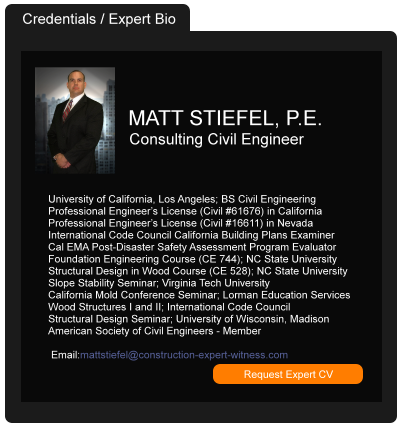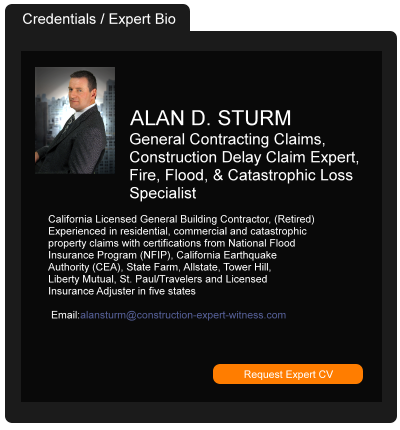Mortenson Subcontractor Fires Worker Over Meta Data Center Noose
April 19, 2022 —
James Leggate - Engineering News-RecordA worker on a data center project for Facebook parent company Meta in Utah was fired after admitting to tying a noose at the worksite where racist graffiti had also been found months earlier.
Reprinted courtesy of
James Leggate, Engineering News-Record
Mr. Leggate may be contacted at leggatej@enr.com
Read the full story... Read the court decisionRead the full story...Reprinted courtesy of
Washington Supreme Court Finds Agent’s Representations in Certificate of Insurance Bind Insurance Company to Additional Insured Coverage
February 03, 2020 —
Jason Taylor - Traub LiebermanIn T-Mobile USA Inc. v. Selective Ins. Co. of Am., 450 P.3d 150 (Wash. 2019) the Washington Supreme Court addressed whether an insurance company is bound by its agent’s written representation—made in a certificate of insurance—that a particular corporation is an additional insured under a given policy. The question arose in a case where: (1) the Ninth Circuit had already ruled that the agent acted with apparent authority, but (2) the agent’s representation turned out to be inconsistent with the policy and (3) the certificate of insurance included additional text broadly disclaiming the certificate’s ability to “amend, extend or alter the coverage afforded by” the policy. According to the Court, under Washington law the answer is yes: an insurance company is bound by the representation of its agent in those circumstances. Otherwise, the Court reasoned, an insurance company’s representations would be meaningless and it could mislead without consequence.
At the heart of this case were two T-Mobiles entities: T-Mobile USA and T-Mobile Northeast (“T-Mobile NE”), which were distinct legal entities. T-Mobile NE engaged a contractor to construct a cell phone tower on a rooftop in New York City. The contract between T-Mobile NE and the contractor required the contractor to obtain a general liability insurance policy, to annually provide T-Mobile NE “with certificates of insurance evidencing [that policy’s] coverage,” and to name T-Mobile NE as an additional insured under the policy. T-Mobile USA was not a party to the contract, but was nonetheless aware of it and approved the contract as to form.
The contractor obtained the required insurance policy from Selective. The policy provided that a third party would automatically become an “additional insured” under the policy if the contractor and the third party entered into their own contract that required the contractor to add the third party to its insurance policy as an additional insured. Because T-Mobile USA did not have a contract with the contractor, it did not automatically become an additional insured under the policy. Nevertheless, over the course of several years, Selective’s agent issued a series of certificates of insurance to “T-Mobile USA Inc., its Subsidiaries and Affiliates” that stated that those entities were “included as an additional insured [under the policy] with respect to” certain areas of coverage. The agent signed those certificates as Selective’s “Authorized Representative.”
Read the court decisionRead the full story...Reprinted courtesy of
Jason Taylor, Traub LiebermanMr. Taylor may be contacted at
jtaylor@tlsslaw.com
Infrared Photography Illuminates Construction Defects and Patent Trolling
October 01, 2013 —
CDJ STAFFReuben Saltzman, a home inspector in the Minneapolis area wrote a piece for the Star Tribune in which he discussed the use of infrared photography in home inspections. Lack of insulation and water intrusion show up clearly on infrared photography where there is not yet any visible damage.
Moist or cold areas show up as darker than their surroundings. Mr. Saltzman included one photo with his article in which the problem shows up as a hot spot: a carpet installer had covered over a floor register.
Mr. Saltzman’s use of infrared photography may be in danger, as he recently learned that a Mississippi firm has actually taken out a patent on using infrared photography for home inspections.
Read the court decisionRead the full story...Reprinted courtesy of
Colorado Statutes of Limitations and Repose, A First Step in Construction Defect Litigation
December 20, 2012 —
CDJ STAFFGrund Dagner, a law firm operating in Denver and Boulder, Colorado notes on their blog that when defending a construction defect claim, one of their first steps is to determine if the claims are affected by the statutes of limitations or repose, and that they “have had much success raising these defenses with the court before trial.”
Colorado has a two-year statute of limitations, starting from when the homeowner discovers the defect. Further, Colorado’s statute of repose precludes lawsuits beginning “more than six years after the substantial completion of the improvement to the real property.”
Grund Dagner notes that they “recently obtained dismissal of claims related to eight of 22 buildings in a condominium project, where the homeowners in those building observed the defects more than two years before the HOA initiated its claims against our client.”
Read the court decisionRead the full story...Reprinted courtesy of
Insurers Subrogating in Arkansas Must Expend Energy to Prove That Their Insureds Have Been Made Whole
July 30, 2019 —
Michael J. Ciamaichelo - The Subrogation StrategistArkansas employs the “made whole” doctrine, which requires an insured to be fully compensated for damages (i.e., to be “made whole”) before the insurer is entitled to recover in subrogation.[1] As the Riley court established, an insurer cannot unilaterally determine that its insured has been made whole (in order to establish a right of subrogation). Rather, in Arkansas, an insurer must establish that the insured has been made whole in one of two ways. First, the insurer and insured can reach an agreement that the insured has been made whole. Second, if the insurer and insured disagree on the issue, the insurer can ask a court to make a legal determination that the insured has been made whole.[2] If an insured has been made whole, the insurer is the real party in interest and must file the subrogation action in its own name.[3] However, when both the insured and an insurer have claims against the same tortfeasor (i.e., when there are both uninsured damages and subrogation damages), the insured is the real party in interest.[4]
In EMC Ins. Cos. v. Entergy Ark., Inc., 2019 U.S. App. LEXIS 14251 (8th Cir. May 14, 2019), EMC Insurance Companies (EMC) filed a subrogation action in the District Court for the Western District of Arkansas alleging that its insureds’ home was damaged by a fire caused by an electric company’s equipment. EMC never obtained an agreement from the insureds or a judicial determination that its insureds had been made whole. In addition, EMC did not allege in the complaint that its insureds had been made whole and did not present any evidence or testimony at trial that its insureds had been made whole. After EMC presented its case-in-chief, the District Court ruled that EMC lacked standing to pursue its subrogation claim because “EMC failed to obtain a legal determination that its insureds had been made whole . . . prior to initiating this subrogation action.” Thus, the District Court granted Entergy Ark., Inc.’s motion for judgment as a matter of law and EMC appealed the decision.
Read the court decisionRead the full story...Reprinted courtesy of
Michael J. Ciamaichelo, White and Williams LLPMr. Ciamaichelo may be contacted at
ciamaichelom@whiteandwilliams.com
Keeping KeyArena's Landmark Lid Overhead at Climate Pledge Arena Redevelopment Is A 22,000-Ton Balancing Act
November 30, 2020 —
Nadine M. Post - Engineering News-RecordMost contractors would jump at the chance to have a roof overhead during a major rebuild. But for the team turning earthquake-prone Seattle’s 411,000-sq-ft KeyArena into the 932,000-sq-ft Climate Pledge Arena, the city-owned facility’s historic helmet has been a 44-million-lb design and construction headache.
Reprinted courtesy of
Nadine M. Post, Engineering News-Record
Ms. Post may be contacted at postn@enr.com
Read the full story... Read the court decisionRead the full story...Reprinted courtesy of
Congratulations to Partner Alex Giannetto for Being Named to San Diego Business Journal’s Top 100 Leaders in Law List
December 03, 2024 —
Dolores Montoya - Bremer Whyte Brown & O'Meara LLPCongratulations to Partner Alexander Giannetto for being selected as a “2024 Leaders of Influence in Law” by the San Diego Business Journal! To read and download the SDBJ publication, please click
here.
Alex Giannetto is a managing partner with Bremer, Whyte, Brown & O’Meara LLP’s San Diego office. He has extensive experience in all aspects of civil litigation handling liability matters including slip and falls, catastrophic injuries, wrongful death, traumatic brain injuries, landslides, and construction claims. He has obtained favorable trial results defending clients on personal injury and premises matters in San Diego and Los Angeles. He also has appellate experience. He is an AV-rated attorney by Martindale-Hubbell who has been voted Best of the Bar in San Diego as well as a Top Lawyer in San Diego.
Read the court decisionRead the full story...Reprinted courtesy of
Dolores Montoya, Bremer Whyte Brown & O'Meara LLP
Legal Risks of Green Building
March 22, 2021 —
Mark D. Shifton - Construction ExecutiveAll construction projects involve elements of legal risk. Insurance and indemnity claims, delay claims and professional negligence claims are simply accepted risks when involved in construction. Green building projects are no exception to this rule, and often involve unique issues that are not present in typical construction projects.
Green building projects commonly employ new or untested construction materials, require construction methods that lack significant track records, and ultimate building performance often fails to meet design expectations. As such, green building projects may give rise to entirely new types of legal risk that should be considered and allocated early in the process.
In the past 15 years, the number of buildings for which green certifications have been sought has grown exponentially, and the growth rate of green building and sustainable construction has far outpaced the growth rate of the construction industry as a whole. As green building projects become increasingly common (and often increasingly required by the federal, as well as state and local governments), the unique legal risks presented by green building projects take on an increase importance.
Reprinted courtesy of
Mark D. Shifton, Construction Executive, a publication of Associated Builders and Contractors. All rights reserved.
Read the court decisionRead the full story...Reprinted courtesy of
Mr. Shifton may be contacted at
mshifton@gllawgroup.com


































































